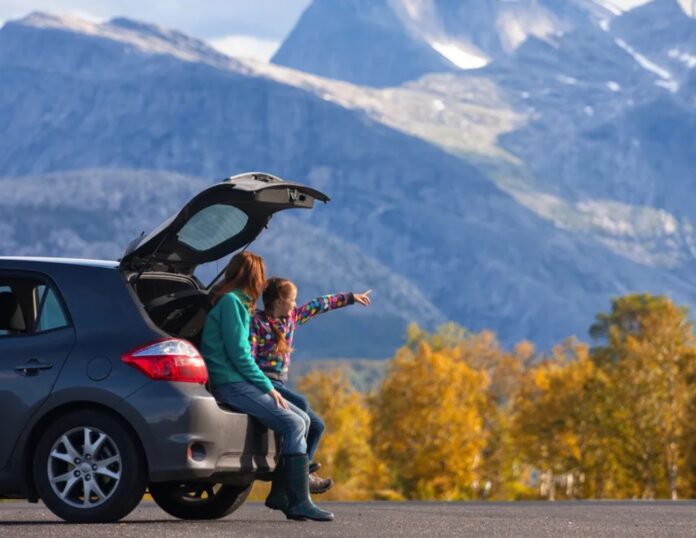
Since some of the most renowned automobile companies are German and the country is famous for its autobahn, doesn’t it seem like a match made in heaven to explore wonderful Germany by car? With its rich historic past, delicious food and wine and varied landscapes, there’s plenty to see, do and enjoy in the heart of Europe.
Germany makes road tripping easy with well maintained and free autobahns, excellent regional and minor roads and great services for drivers. Bear in mind that, contrary to popular belief, there are speed limits in autobahns, especially in urban areas! There are no tolls in Germany.
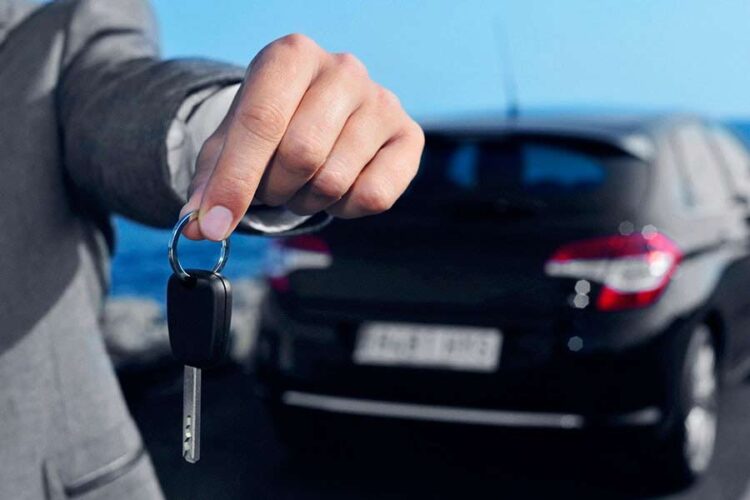
Renting A Car in Germany
Most rental vehicles in the country are manuals. There are very few automatics and they are generally midsize and large automobiles. If you’re a savvy driver you can opt for a manual but if you’re a novice, opting for an automatic car is a better decision. With comfort in mind, and assuming that you’ll be spending plenty of time on the road and in the car, it’s wiser to opt for a larger and more comfortable vehicle where you don’t feel crammed inside.
Make sure you’re familiar with German driving laws as they may differ from the ones in your home country. Despite Germany being a safe country to drive, avoid unnecessary distractions while you’re driving. That said, it’s a good idea to be extra cautious and invest in an insurance policy for the car you rent. The agency will offer you theirs, your credit card may also provide you with some coverage and even your own car insurance policy may do as well. However, some of them can cost you quite a fortune and don’t provide you with the coverage that you need driving abroad. Make sure you explore your alternatives in depth; you may find a convenient third party insurer here.
Is Parking Easy?
We’ve been there: you’ve got a nice car that takes you everywhere you want but then you spend hours on end driving in circles finding somewhere to park it. Fortunately, Germans have thought about this and parking is not mission impossible. Apart from the parking lot you may find at many hotels, there is plenty of public parking space available that is metered unless the sign allows the use of a parking disc. You’ll find the parking disc in the glove box of the car. Just use the dial and round up to the nearest time on the dial. After you set the time you must display this in your window for parking attendants.
Now that everything is set, you’re ready to explore the different and exciting paths that Germany has to offer:
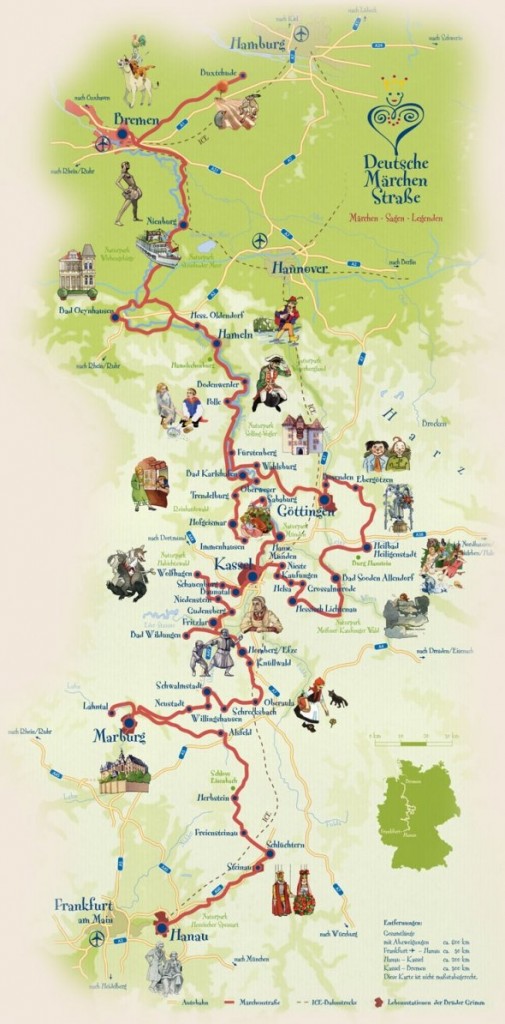
Germany’s Fairytale Road
The 600-km-long Märchenstrasse or Fairy Tale Road is one of the most popular scenic routes in the country. There are more than 60 stops along the way that include cities, towns and hamlets in four states that are all associated with the works of Wilhelm and Jacob Grimm. It’s a fantastic drive for both children and adults who get the chance of knowing the real story behind some of the most popular fairy tales.
The first stop is in Steinau, the birthplace of the Grimm Brothers. The house where they lived is now open to the public as a museum. The charming surroundings seem to be taken out of their own fairy tales: half-timbered houses, twisting cobbled alleys and the turreted Schloss Steinau that overlooks the whole town. Don’t miss the Brüder Grimm Haus and Steinau Museum, which depict works of the artists. Take the back roads to Marburg and enjoy the gorgeous landscapes and admire its beautiful Gothic castle-palace on the hill that can easily be where Cinderella’s prince lived. With its lively bars and restaurants, it’s a great place for an overnight stop.
Take a stroll through the Little Red Riding Hood in the Schwalm region. The local museum features traditional costumes that Little Red Riding Hood and her granny wore and in Alsfeld you can see Little Red Riding Hood’s House.
From there, head to Kassel,where the Grimm Brothers spent their teenage years. There you can browse the Brüder Grimm Museum and the Schloss und Bergpark Wilhelmshöhe. Don’t miss Grimm World! It features interactive exhibits and Brother Grimm’s personal copy of Children’s and Household Tales. If Sleeping Beauty is your favorite fairy tale, discover Castle Sababurg; you can climb up the castle tower and experience Sleeping Beauty’s tale or enjoy a theater performance in the courtyard.
Gottingen will be your next stop. The Grimm Brothers served as professors at the University of Gottingen. Make your way to the traditional central square where you can admire the statue of Ganseliesel, the little goose girl of German lore. Bad Wildungen has a Snow White Museum and its castle can be visited in Weilburg!
Hameln, or Hamelin, is next up and it’s one of the most famous fairy tale destinations in Europe. It’s the home of the Pied Piper, who rid the town of rats in 1284 only to be cheated out of his payment. The Pied Piper returned to Hameln a year later and lured away all the children. The story is reenacted in the town center every year during the Spring months and it’s lovely to view!
The city of Bremen where you can admire the Roselius-Haus Museum, St Petri Dom and the statue of the Bremen musicians and heroes of the Brothers Grimm story and Trendelburg Castle to see where Rapunzel was imprisoned by the bad witch.
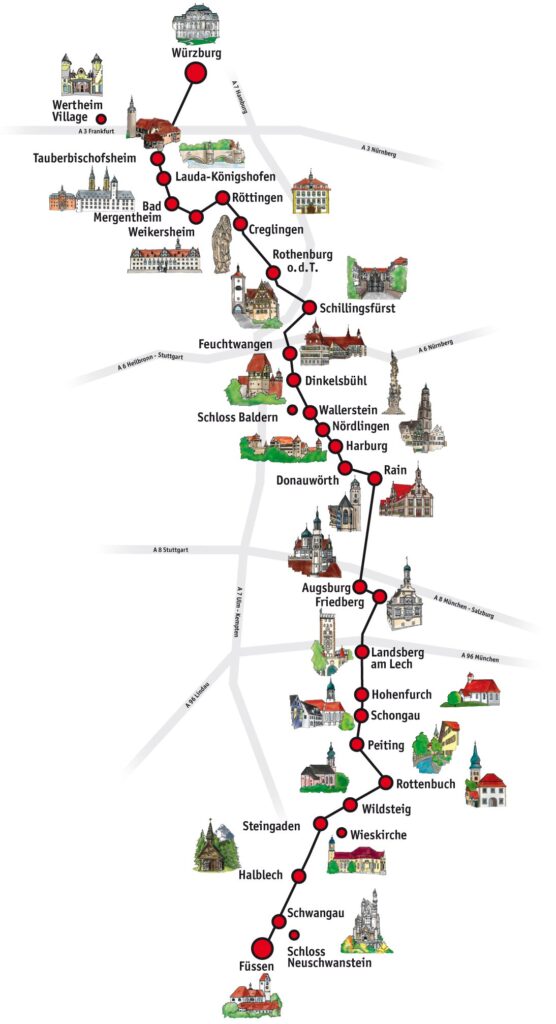
The Romantic Route
The Romantic Route or Romantische Strasse is 350km long and it’s one of the most beautiful and popular German touring routes. From the vineyards of Würzburg to the foot of the Alps, this well-trodden path runs through southern Germany finding its climax at the gates of King Ludwig II’s crazy castles. The route links some of the country’s most picturesque towns, many of which still keep the charm of medieval times.
Make sure you have plenty of time for this road trip. Even though it can easily be done in a couple of days, we suggest you take at least five in order to be able to stop and explore many of the almost 30 towns along the route.
Start your drive at the Würzburg wine region. The route winds through Rothenburg ob der Tauber, the well-preserved medieval town that inspired Disney’s Pinnocchio. Take your time to explore its charming maze of narrow streets and timbered buildings.
Then you’ll head south to Dinkelsbühl , a quaint medieval town that’s famous for its fortified walls, 18 looming towers and stunning city gates. Continue your trip towards the iconic Neuschwanstein Castle, one of Europe’s most visited attractions.
Your final stop is Füssen. The town’s pastel-hued historic centre is packed with cultural gems such as St Mang’s Abbey, the Benedictine monastery and the Gothic Hohes Schloss. Füssen is a great spot to do outdoor activities such as paragliding, sailing, hiking and much more.
The Romantic Road takes tourists across Bavaria and as you drive you’ll discover incredibly beautiful and picturesque towns. Take your time to enjoy great folklore festivals and nice restaurants where you can enjoy many world-class wines that any wine lover has to try. It has it all: nature, culture and friendly hospitality. On the way between Würzburg and Füssen you’ll cross the charming Tauber Valley, the geological hotspot of Nördlinger Ries, the picturesque Lechfeld and the idyllic Pfaffenwinkel region at the foot of the Alps in Upper Bavaria.
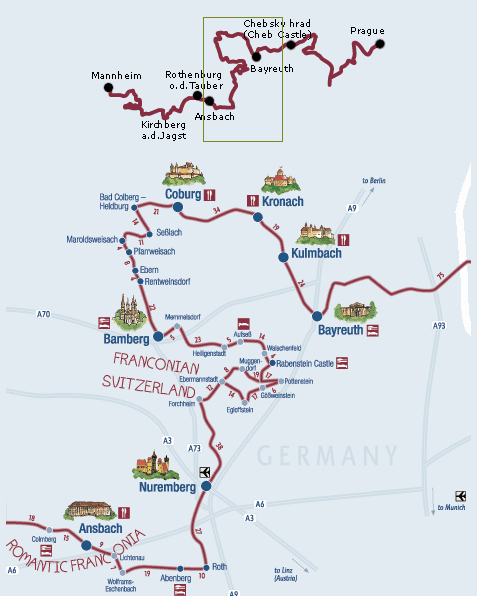
The Castle Route
The German Castle Road will take you castle-hopping across 600km of southern Germany and through a thousand years of the country’s history. From the impressive baroque castle in Mannheim to Bayreuth’s Altes Schloss, you’ll have a good share of palaces to enjoy.
The Castle Route or Burgenstrasse is 1200km long and starts at Mannheim Palace and crosses Bavaria before heading into neighbouring Czech Republic. It’s the road trip to do for anyone looking to explore more than a thousand years of Central European history, especially if you choose to stay in some of the castles on the way, like Castle Hornberg, which is now a hotel.
The road itself consists of a series of small, winding back roads with easy to follow signs. The route is available online if you want to plan it beforehand and it offers tourists plenty of useful information such as exact distances between castles and cities. With over 70 castles to visit, it’s wiser to pick just a few castles to explore in depth and enjoy the magnificent view of the other castles from afar. Amongst the ones you can’t miss are the Schwetzingen Castle, Heidelberg Castle, the Castle of Neuenstein, the Imperial Castle of Nuremberg, the Residenz in Bamberg and the Castle at Colmberg which is a castle-hotel where you can spend the night.
You’ll follow the trail of emperors, kings, princes, knights, count palatines and tales of romance and enjoy no shortage of sagas, fairy tales, legends and myths. It’s definitely an unforgettable experience as you drive through sacred and secular buildings, historical sites and cultural gems.
Ride the funicular up the XIII century Heidelberg Castle for the apothecary museum and an enchanting panoramic view of the old town Heidelberg. Stop at the brewery of Schwetzingen Castle and cross the stone bridge to Castle Guttenberg for a live falcon show and medieval performance. Other highlights include the old village of Neckarsteinach, Ritterschloss Knight’s Castle and restaurant and the medieval spa of Bad Wimpfen.
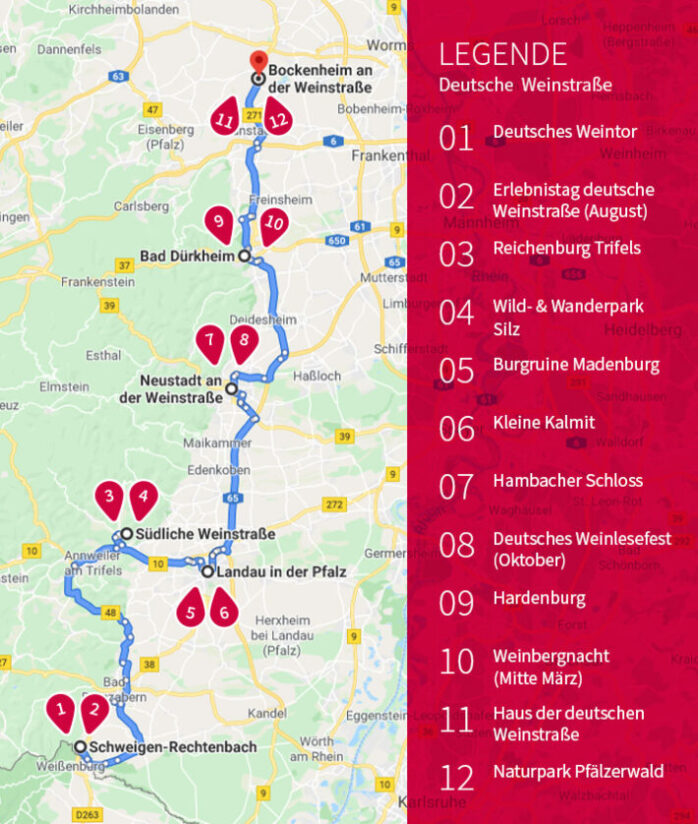
The Wine Route
Located in the heart of the Palatinate region, the Wine Route is one of the loveliest and oldest touring routes. From the French border you’ll drive northwards along this route through Germany’s largest wine-growing area.
The Weinstrasse is only 85 km long and you can easily complete it in a day or two. It starts on the French-German border in the town of Schweigen-Rechtenbach before sweeping through the Palatinate wine region towards Bockenheim an der Weinstraße. Along the way, you’ll be able to admire the world’s biggest wine barrel in Bad Dürkheim while the cable car in Koblenz cannot be missed as it gives excellent views across the region. Take your time to visit charming old restaurants, quaint wine villages and picturesque vineyards and, if you have the chance, participate in the many local harvest festivals that are celebrated throughout the spring and summer months.
Amongst the towns you’ll drive through we can mention Bad Bergzabern, Edenkoben, Neustadt an der Weinstraße, Deidesheim, Bad Dürkheim und Grünstadt.
The Baden Wine Route takes visitors on a 500-km-long adventure through the Baden Wine Region. Visitors can only explore the edge of the Black Forest and the foothills of the Upper Rhine Valley as well. It’s the ideal wine road trip for those who have always wanted to go from wine cellar to wine cellar. You’ll pass through the wine-growing areas of the Baden Mountain Route, Kraichgau, Ortenau, Kaiserstuhl, Tuniberg, Breisgau and Markgräflerland.
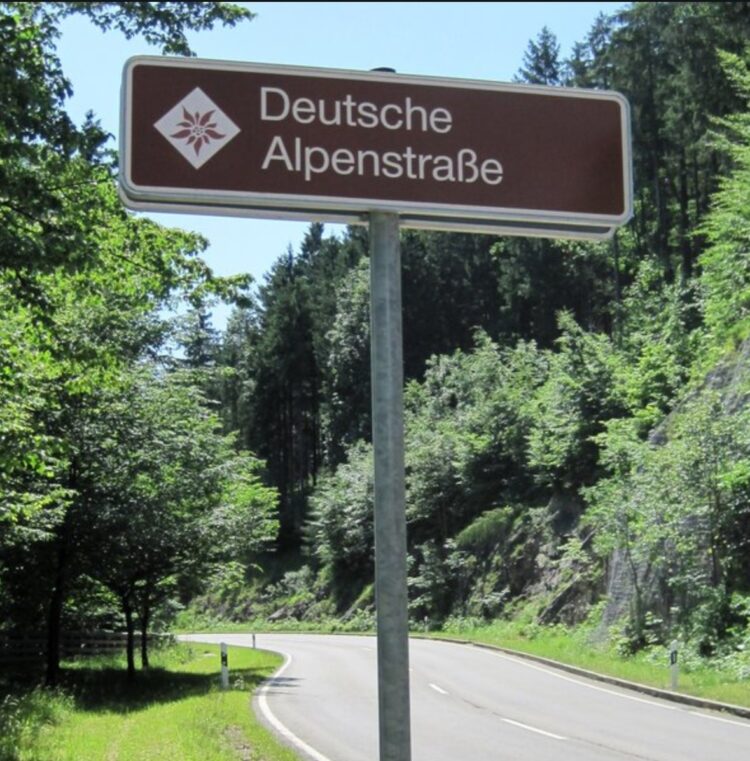
The Alpine Road
The Alpenstrasse, as it’s known in German, was the country’s first touring road and it dates from 1858 and it takes tourists through the foothills of the Bavarian Alps. It invites you to explore one of King Ludwig II’s castles or take a boat ride across one of the many Alpine lakes in the area.
Starting in Lindau on the shores of Lake Constance, the route winds 450km on Alpine roads that twist along Germany’s extreme south to the stunning Köningsee, a lake near the German-Austrian border close to Salzburg. As you drive forward you’ll see many crystal-clear lakes, ski resorts and the mountainous German charm. The highlights are Mount Zugspitze, the country’s highest peak; King Ludwig II’S castles including Herrenchiemsee and Neuschwanstein; Oberammergau, Lake Walchensee east from Füssen and Lake Königssee. The route runs from Lindau up into the Allgäu Alps before following the Oberjoch Pass. It’s one of the region’s most scenic driving routes with 106 challenging bends. It follows on Schönau on Lake Königsee and carves its way through numerous picturesque villages, alpine pastures and crystal lakes.
The route will introduce you to the stunning Alpine landscapes and the uniquely rich Bavarian culture in the south of Germany. Venture eastwards to the Breitachklamm gorge, hit the slopes of Garmisch-Partenkirchen and stop at Benediktbeuern on your way to the medieval town of Bad Töltz, then up through the beautiful wilderness scenes of the Chiemgau Alps before ending in the regional capital of Munich.
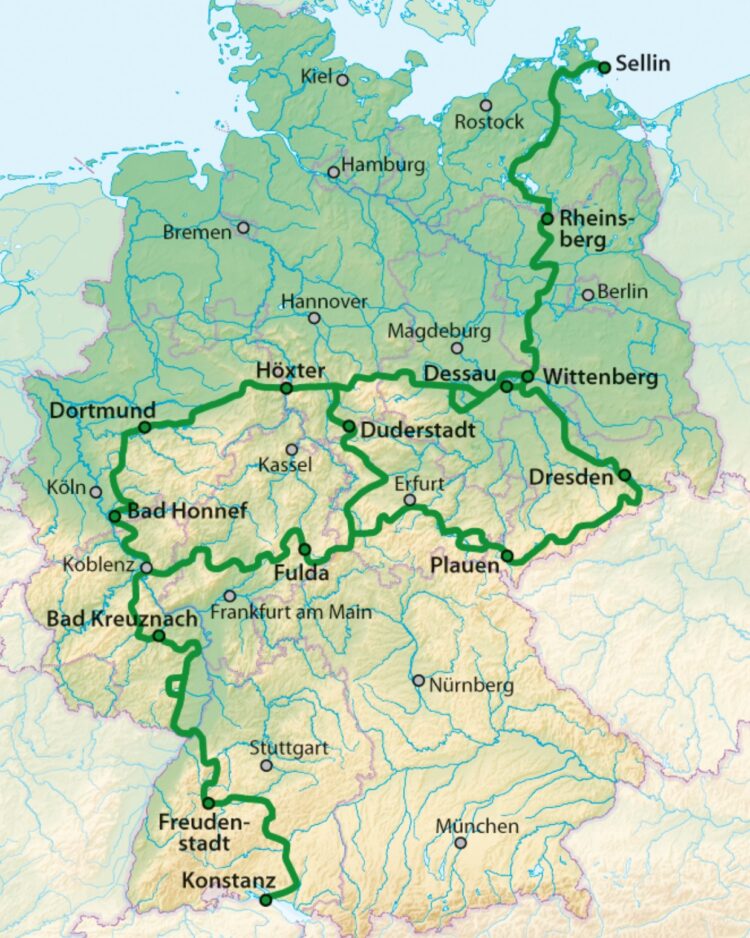
The Avenues Route
The Avenues Route is considered by many the quintessential German road trip as you drive along the tree-lined avenues of the Harz Mountains and country highways of central Germany. Take your time to admire the natural beauty of the ancient states of Saxony-Anhalt, Lower Saxony, Thuringia and Saxony. The quaint villages of Goslar and Quedlinburg will definitely catch your attention.
The Avenues Route is 3000 km long and it runs like a green ribbon from the Baltic Sea island of Rügen to the UNESCO World Heritage Site of Reichenau Island in Lake Constance. Many are small, quiet country roads lined with ancient trees. Some of the highlights along the way are: Nationalpark Jasmund, the Hanseatic city of Stralsund, the Bauhaus in Dessau and the Dessau-Wörlitz Gartenreich.
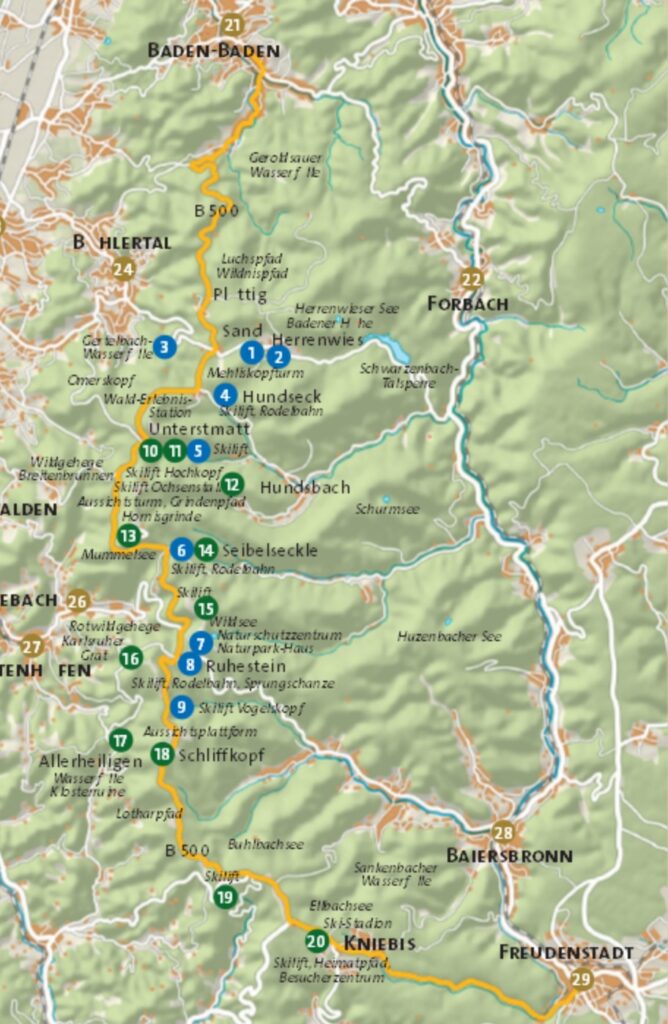
The Schwarzwaldhochstrasse or Black Forest High Road
Those who’ve dreamt about enjoying a road trip in the deep Black Forest shouldn’t miss the chance of driving the Schwarzwaldhochstrasse, a really lovely drive! It’s a road with altitude that offers constant views over hills. You’ll drive southwards from the spa town of Baden-Baden to Freudenstadt, passing heather-flecked woodlands, luscious meadows, waterfalls, lakes and stout farmhouses. It meanders scenically past toytown villages, glacial lakes and almost infinite valleys and forests. It’s an enjoyable road trip at any time of the year.
The Black Forest High Road is 60km long and it takes in the highest point of the luscious Black Forest offering quite unforgettable views of the region. The route starts in Freudenstadt and goes north to Baden-Baden and rises along two mountain ranges _ Kniebis and Schliffkopf_. The highest area is at Hornisgrinde and around. It’s a gorgeous driving route that is part of the B500 Highway. It’s perfect for a weekend break though you can also do it in a day.
Flanked by a number of interesting towns such as Freiburg or Baden-Baden, the Black Forest High Road is where you can enjoy a slice of the delicious Black Forest Cake. The area is also famous for its over thousand distilleries that make schnapps. If interested, you can join the Schnapps Walking Trail out of the little town of Sasbachwalden.
The road sweeps fast through the landscape and allows you to take in the views while cruising. As it runs alongside the stunning Vosges Mountains, it offers breathtaking views of the Black Forest and Rhine Valleys. At midpoint, you’ll come across the legendary Mummelsee, a circular glacial lake that formed after the last Ice Age.
Considered by many as a fairytale-like road trip and one of the most emblematic ones in Germany, it’s one of the must-do drives if you’re touring the country.











